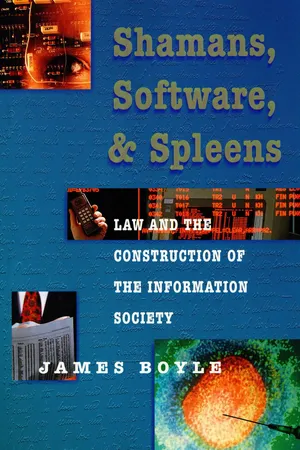
- English
- PDF
- Available on iOS & Android
Shamans, Software, and Spleens
About This Book
Who owns your genetic information? Might it be the doctors who, in the course of removing your spleen, decode a few cells and turn them into a patented product? In 1990 the Supreme Court of California said yes, marking another milestone on the information superhighway. This extraordinary case is one of the many that James Boyle takes up in Shamans, Software, and Spleens, a timely look at the infinitely tricky problems posed by the information society. Discussing topics ranging from blackmail and insider trading to artificial intelligence (with good-humored stops in microeconomics, intellectual property, and cultural studies along the way), Boyle has produced a work that can fairly be called the first social theory of the information age.Now more than ever, information is power, and questions about who owns it, who controls it, and who gets to use it carry powerful implications. These are the questions Boyle explores in matters as diverse as autodialers and direct advertising, electronic bulletin boards and consumer databases, ethno-botany and indigenous pharmaceuticals, the right of publicity (why Johnny Carson owns the phrase "Here's Johnny!"), and the right to privacy (does J. D. Salinger "own" the letters he's sent?). Boyle finds that our ideas about intellectual property rights rest on the notion of the Romantic author--a notion that Boyle maintains is not only outmoded but actually counterproductive, restricting debate, slowing innovation, and widening the gap between rich and poor nations. What emerges from this lively discussion is a compelling argument for relaxing the initial protection of authors' works and expanding the concept of the fair use of information. For those with an interest in the legal, ethical, and economic ramifications of the dissemination of information--in short, for every member of the information society, willing or unwilling--this book makes a case that cannot be ignored.
Frequently asked questions
Information
Table of contents
- Contents
- Preface
- 1 The Information Society
- 2 Four Puzzles
- 3 The Public and Private Realms
- 4 Information Economics
- 5 Intellectual Property and the Liberal State
- 6 Copyright and the Invention of Authorship
- 7 Blackmail
- 8 Insider Trading and the Romantic Entrepreneur
- 9 Spleens
- 10 Stereotyping Information and Searching for an Author
- 11 The International Political Economy of Authorship
- 12 Private Censors, Transgenic Slavery, and Electronic Indenture
- 13 Proposals and Objections
- Conclusion
- Appendix A. An Afterword on Method
- Appendix B. The Bellagio Declaration
- Notes
- Acknowledgments
- Index